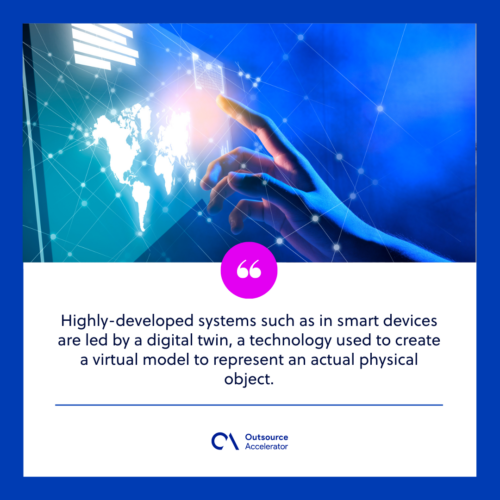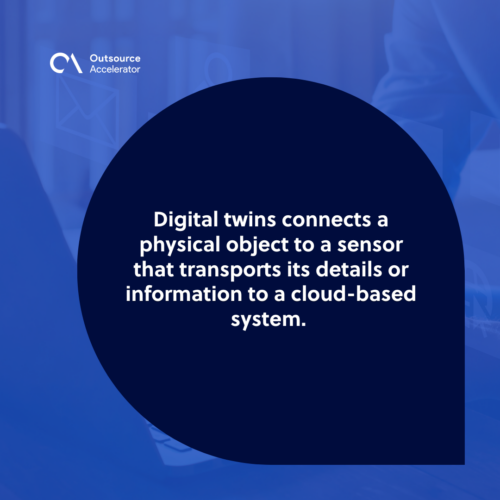Digital twin and its role with technology

The advancements in technology have welcomed inventions that are more complex than ever. The devices we currently work with are more than just about being a computer.
The internet of things (IoT) is now being developed and programmed into something human-like to simulate real-life situations. Consequently, digital twins are also used to improve these IoT.
What is digital twin technology?
Highly-developed systems such as in smart devices are led by a digital twin, a technology used to create a virtual model to represent an actual physical object. It uses real-time data from sensors, produces performance and effectiveness results, and points out potential issues.

Digital twins allow manufacturers to oversee products and be further improved before moving on to development. Today, they are being utilized in the construction of buildings and factories and even in the urbanization of some areas.
How does it work?
Digital twins act as a bridge to connect physical and digital environments. With this technology, manufacturers can double or triple-check their projects to ensure that they are accurate and error-free. It provides a sense of safety across industries.
It connects a physical object to a sensor that transports its details or information to a cloud-based system. This system is then used to assemble the digital version of the item.

Once finally printed, the digital twin of the object can be used to examine performance problems, durability, and improvement. Results in this simulation will be applied to the real-life manufacturing process.
How was it developed?
The idea of connecting different devices into a single network has always been considered ever since. This stems from the fascination with IoT and other machines that are becoming more complex and systemized.
Kevin Ashton talked about his vision in 1999, where these IoT and physical components can work together in a single system.
In 2002, the digital twin was first applied to the manufacturing industry and was formally introduced as a digital twin software concept by Dr. Michael Grieves, a faculty member of the University of Michigan. However, it was shortened to just “digital twin” in 2010.
Why is it important?
A digital twin helps corporations save time and oversee the preparations for product development without challenges. This technology allows projects to be easily calculated and tested.
As we further delve into modernization, giant companies are slowly incorporating digital twins in their operations to utilize for expeditions. Due to its high demand, the global digital twin market was valued at $7.5 million in 2021.
Types of digital twin technology
Component twins
Component twins are the primary and most diminutive forms of a digital twin. These are the integral parts of a model that can directly impact its performance, function, and lifespan.
Rather than printing an entirely digital model, engineers only use component twins to examine the essential parts, such as screws or gears, that are prone to heat and stress exposure for improvement.
Asset twins
Also known as product twins, asset twins are considered to be a digital model of the product itself rather than its parts.
These are two or more components to inspect their interaction in a system, producing performance data that can be used for better understanding and upgrade opportunities.
Unit twins
Composed of combined individual asset twins, unit twins provide a clearer magnification of how assets work together to function.
The difference between unit and asset twins is that unit twins provide a clear digital copy of products, which assets produce, in a system to comprehend the collaboration of each. This will eventually maximize the project’s performance with minimum wear and tear.
Process twins
Process twins are the highest form of digital twins. This type can produce a digital copy of an entire production facility to study operational efficiency. As the name suggests, systems reviewed here cover how well-defined or lacking a particular process of a project is.
Process twins allow designers to study specific timing strategies to enhance a system’s overall effectiveness.
Benefits of using digital twin technology
Improved efficiency
Sourcing real-time data from digital twins provides manufacturers to optimize the performance of factories and equipment. Whenever issues arise, this technology’s fast rendering of information allows companies to act quickly and reflect a significant decrease in downtimes.

Another benefit of digital twins lies in improved customer experience. It also guarantees rapport with your market by hearing customer concerns and applying them to your existing products, services, and operations.
Enhanced research and design
The real-time data transfer feature in digital twins allows companies to exert more effort in product development. With an object’s digital replica, there are more chances of achieving impressive product quality and enhancing design and performance.
Engineers can quickly determine what needs to be worked on–internally and externally–through digital twins, so items would have the full capacity to function well.
Managed risk
Unlike in the conventional method of test runs, designers can now already identify a product’s potential risks and challenges through digital twins.
It analyzes different situations and risk predictions concerning logistics, market response and performance, and maintenance and suggests supplementary solutions.
The future is with digital twin technology
As the world continues to globalize, the advancement of digital twins is here to stay.
With continuous digital network expansion, high-technology inventions like digital twins benefit the industrial sector, the market, and the consumers.
This technology provides an advantage in developing well-functioning products and increasing workload efficiency. The decrease in operational costs, downtimes, and nonfunctional items also allow designers to address potential problems quickly.
Companies can now understand the market’s needs more and offer them what they actually need without struggle.







 Independent
Independent




